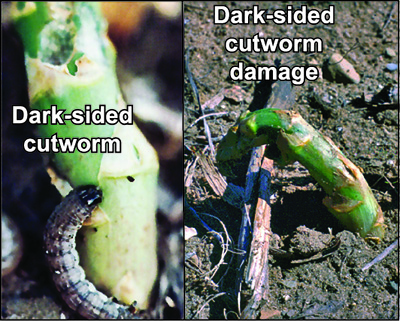A tale of two cutworms: Cutworm control in asparagus
Spring time is cutworm time in asparagus. Learn about their biology and control.

Cutworm appearance and life cycle
Michigan asparagus is attacked by white cutworms, Euxoa scandens, and dark-sided cutworms, Euxoa messoria. Both species overwinter in Michigan, are present in many habitats and feed on many plants.
White cutworm moths fly from late June to mid-August. Females lay eggs singly or in small groups 0.25-0.5 inch deep in the soil, preferring sandy sites. Caterpillars hatch in August and have a translucent, milky white appearance. They feed on weeds and asparagus in the fall before burrowing into soil to overwinter as 0.5-0.75 inch long larvae. They emerge in early spring and pupate in late June, emerging in July as the next generation of moths. There is one generation per year.
Dark-sided cutworm moths are active from mid-August through October and lay eggs singly or in small groups 0.25-0.5 inch deep in the soil, including in asparagus fields. Eggs overwinter in the soil and hatch in April. Caterpillars are 1.5 inches when fully grown and are grayish with brownish, indistinct lines along their sides. They feed on weeds and volunteer asparagus from April through July before pupating in July or early August. There is one generation per year.
Cutworm damage
White cutworms can be active at near-freezing temperatures, emerging large and ready to feed at spear emergence. Caterpillars feed at night, climbing spears to damage tips or eat butts of harvested spears. This means damage is most severe during the first harvests when few butts are present, and generally lessens through the end of May. Feeding damage is also more severe during cool springs as slow-growing spears are exposed to cutworms for a longer time before harvest.
Dark-sided cutworms hatch in the spring as small larvae and are not large enough to cause significant damage until the second half of May through the end of harvest, with damage more severe as caterpillars grow. Unlike white cutworms, dark-sided cutworms do not climb spears. Instead, they feed at the base of spears at the soil surface. This causes the undamaged side of the spear to grow faster than the damaged side, resulting in crooked spears. Crooked spears may even be curled into partial spirals.

How to scout for cutworms
Cutworms are in the soil during the day, so damage is the main cue to their presence. Michigan State University Extension recommends sampling 20 plants at five locations scattered throughout the field. If you detect cutworm damage on more than 5 percent of plants, dig 1-inch deep in a 6-inch radius of damaged spears with a weed fork to confirm the presence of cutworms.
Lookalikes
Crooked spears can result from any damage to the side of a spear, including Phytophthora asparagi and wind-blown sand. Patterns of damage can help distinguish them from cutworms. Phytophthora is most severe in low areas with standing water and affected spears have a water-soaked area at their base. Damage from wind-blown sand is most severe in areas exposed to wind – i.e., where protective rye covers established poorly – and produces crooks oriented towards prevailing winds.
Cutworm management options
Cultural controls
Good weed control may reduce egglaying and larval survival.
Chemical controls
Trials in the 1980s showed permethrin was as effective as chlorpyrifos (chlorpyrifos is no longer legal to use). Permethrin is also more active at cool spring temperatures. Permethrin applications can be made early in the season for white cutworms and later for dark-sided cutworms. Higher rates of permethrin should be used when populations are high and cutworms are large. Control likely occurs due to cutworm contact with treated soil, rye covers and spears. Good soil moisture can increase efficacy. Not all cutworms are active each night, so repeated applications may be necessary. Some growers band-apply these insecticides over the row, which can save product as white cutworm is not present between rows.
Fall applications of insecticides can be made to control white cutworm. However, up to 80% of larvae can die over the winter, so fall sprays may not be a cost-effective management strategy. Spinosad baits are available for organic growers, but are only labelled for application in the fern season. Efficacy has not been tested by MSU.
|
Preferred products for cutworm control in asparagus |
|||
|---|---|---|---|
|
Product active ingredient |
Rate |
Pre-harvest interval |
Restrictions |
|
Permethrin (3.2EC) |
1 day |
16 oz max per year |
|



 Print
Print Email
Email




